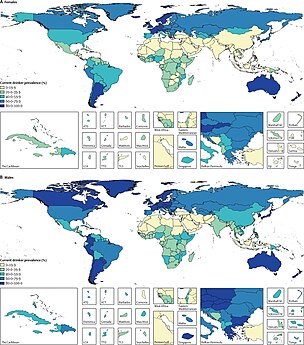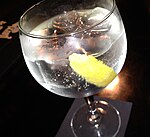Alcoholic beverage
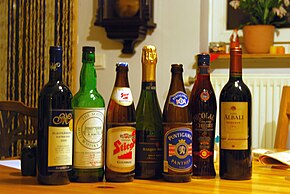
Analcoholic beverage(also called anadult beverage,alcoholic drink,strong drink,or simply adrink) is abeveragecontainingalcohol (ethanol).Alcoholic drinks are typically divided into three classes—beers,wines,andspirits—and typically their alcohol content is between 3% and 50%.
Many cultures have a distinctdrinking culture,where alcoholic drinks are integrated intoparties.Most countries havelawsregulating the production, sale, and consumption of alcoholic beverages.[1]For example, some regulations may require the labeling of the percentage alcohol content (asABVorproof) and the use of awarning label.Some countriesban the consumption of alcoholic drinks,but they are legal in most parts of the world. Thetemperance movementadvocates against the consumption of alcoholic beverages.[2]The globalalcoholic drink industryexceeded $1.5 trillion in 2017.[3]Alcohol is one of the most widely usedrecreational drugsin the world, and about 33% of all humans currently drink alcohol.[4]In 2015, amongAmericans,86% of adults had consumed alcohol at some point, with 70% drinking it in the last year and 56% in the last month.[5]Several other animals are affected by alcohol similarly to humans and, once they consume it, will consume it again if given the opportunity, though humans are the only species known to produce alcoholic drinks intentionally.[6]
Alcohol is adepressant,which in low doses causeseuphoria,reducesanxiety,and increases sociability. In higher doses, it causesdrunkenness,stupor,unconsciousness,ordeath.Long-term use can lead to analcohol use disorder,an increased risk of developingseveral types of cancer,cardiovascular disease,andphysical dependence.
Alcoholis classified as acarcinogen.According to theWorld Health Organization,any alcohol consumption may cause health problems.
History
[edit]Prehistory
[edit]Discovery of lateStone Agejugs suggests that intentionally fermented drinks existed at least as early as the Neolithic period.[7]
The oldest verifiablebreweryhas been found in a prehistoric burial site in a cave nearHaifain modern-dayIsrael.Researchers have found residue of 13,000-year-old beer that they think might have been used for ritual feasts to honor the dead. The traces of a wheat-and-barley-based alcohol were found in stone mortars carved into the cave floor.[8]
Ancient period
[edit]
TheCarmona Wine Urnis a first centuryRomanglassurn containing intactwine.Discovered in 2019 inCarmona, Spainduring excavations of the city's western Romannecropolis,analysis of the urn's contents five years after has deemed the vessel as the oldest surviving wine in the world, surpassing the previous record holder, theSpeyer wine bottle(discovered in 1867) by three centuries.[9][10]
Beer was likely brewed frombarleyas early as 13,000 years ago in the Middle East.[11]Pliny the Elderwrote about thegolden ageof winemaking inRome,the 2nd century BCE (200–100 BCE), whenvineyardswere planted.[12]
Examination and analysis of ancientpotteryjars from the neolithic village ofJiahuin theHenanprovince of northern China revealed residue left behind by the alcoholic drinks they had once contained. According to a study published in theProceedings of the National Academy of Sciences,chemical analysis of the residue confirmed that a fermented drink made of grape and hawthorn fruit wine, honey mead and rice beer was being produced in 7000–5600 BC (McGovern et al., 2005; McGovern 2009).[13][14]The results of this analysis were published in December 2004.[15]
The earliest evidence ofwinemakingwas dated at 6,000 to 5,800 BCE inGeorgiain theSouth Caucasus.[16]
Celtic people were known to have been making types of alcoholic cider as early as 3000 BC.[17][18]and wine was consumed in Classical Greece at breakfast or atsymposia,and in the 1st century BC.[19]
Medieval period
[edit]Medieval Middle East
[edit]MedievalMuslim chemistssuch asJābir ibn Ḥayyān(Latin: Geber, ninth century) andAbū Bakr al-Rāzī(Latin: Rhazes,c. 865–925) experimented extensively with the distillation of various substances. The distillation of wine is attested in Arabic works attributed toal-Kindī(c. 801–873 CE) and toal-Fārābī(c. 872–950), and in the 28th book ofal-Zahrāwī's (Latin: Abulcasis, 936–1013)Kitāb al-Taṣrīf(later translated into Latin asLiber servatoris).[20]12th century: The process of distillation spread from theMiddle Eastto Italy,[21]where distilled alcoholic drinks were recorded in the mid-12th century.[21]
Medieval Europe
[edit]In Italy, the works ofTaddeo Alderotti(1223–1296) describe a method for concentrating alcohol involving repeatedfractional distillationthrough a water-cooled still.[22]By the early 14th century, distilled alcoholic drinks had spread throughout theEuropean continent.[21]Distillation spread toIrelandandScotlandno later than the 15th century, as did the common European practice of distilling "aqua vitae",primarily for medicinal purposes.[23]
Early modern period
[edit]in 1690, England passed "An Act for the Encouraging of the Distillation of Brandy and Spirits from Corn"[24]Alcoholic beverages played an important role in theThirteen Coloniesfrom their early days when drinking wine and beer at that time was safer than drinking water – which was usually taken from sources also used to dispose of sewage and garbage.[25]Drinking hard liquor was common occurrence in early nineteenth-century United States.[26]
TheWhiskey Rebellion(also known as the Whiskey Insurrection) was a violenttax protestin the United States beginning in 1791 and ending in 1794 during thepresidency of George Washington.The so-called "whiskey tax" was the first tax imposed on a domestic product by the newly formed federal government. Beer was difficult to transport and spoiled more easily than rum and whiskey.
Modern period
[edit]TheRum Rebellionof 1808 was acoup d'étatin the then-Britishpenal colonyofNew South Wales,staged by theNew South Wales Corpsin order to deposeGovernorWilliam Bligh.Australia's first and only military coup, its name derives from the illicit rum trade of earlySydney,over which the 'Rum Corps', as it became known, maintained a monopoly. During the first half of the 19th century, it was widely referred to in Australia as theGreat Rebellion.[27]Thealcohol monopolysystem has a long history in various countries, often implemented to limit the availability and consumption of alcohol for public health and social welfare reasons.
Thealcohol monopolywas created in the Swedish town ofFalunin 1850, to prevent overconsumption and reduce theprofit motivefor sales of alcohol. It later went all over the country in 1905 when theSwedish parliamentordered all sales of vodka to be done via local alcohol monopolies.[28]In 1894, theRussian Empireestablished a state monopoly on vodka, which became a major source of revenue for the Russian government.
Later in the nineteenth century opposition to alcohol grew in the form of thetemperance movement,in theUnited States,United Kingdom,Canada,ScandinaviaandIndia,and it eventually led to national prohibitionsin Canada(1918 to 1920), Norway (spirits only from1919to1926), Finland (1919 to 1932), andthe United States(1920 to 1933), as well as provincial prohibitionin India(1948 to present).[29]
Fermented drinks
[edit]Beer
[edit]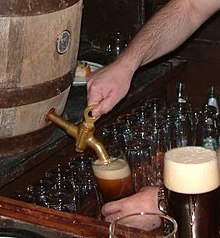
Beeris a beverage fermented fromgrainmash.It is typically made frombarleyor ablendof several grains and flavored withhops.Most beer is naturally carbonated as part of the fermentation process. If the fermented mash is distilled, then the drink becomes aspirit.Beer is the most consumed alcoholic beverage in the world.[30]
Cider
[edit]Cideror cyder (/ˈsaɪdər/SY-dər) is afermentedalcoholic drink made from anyfruit juice;apple juice(traditional and most common),peaches,pears( "Perry"cider) or other fruit. Cider alcohol content varies from 1.2%ABVto 8.5% or more in traditional English ciders. In some regions, cider may be called "apple wine".[31]
Fermented water
[edit]Fermented water is anethanol-based water solution with approximately 15-17% ABV withoutsweet reserve.Fermented water isexclusivelyfermentedwithwhite sugar,yeast,and water. Fermented water is clarified after the fermentation to produce a colorless or off-white liquid with no discernible taste other than that ofethanol.
Mead
[edit]Mead(/miːd/), also called hydromel, is an alcoholic drink made by fermenting honey with water, sometimes with variousfruits,spices,grains,orhops.The alcoholic content of mead may range from as low as 3% ABV to more than 20%. The defining characteristic of mead is that the majority of the drink's fermentable sugar is derived from honey. Mead can also be referred to as "honeywine."
Pulque
[edit]Pulqueis theMesoamericanfermented drink made from the "honey water" ofmaguey,Agave americana.Pulque can be distilled to producetequilaorMezcal.[32]
Rice wine
[edit]Rice wine is an alcoholic drinkfermentedand possiblydistilledfromrice,consumed inEast Asia,Southeast AsiaandSouth Asia.Sake,huangjiu,mijiu,andcheongjuare popular examples ofEast Asianrice wine.
Wine
[edit]
Wineis a fermented beverage most commonly produced fromgrapes.Wine involves a longer fermentation process than beer and often a longaging process(months or years), resulting in an alcohol content of 9%–16%ABV.
Sparkling winessuchFrenchChampagne,CatalanCavaorItalianProseccoare also made from grapes, with asecondary fermentation.
Fruit winesare made from fruits other thangrapes,such asplums,cherries,orapples.
Distilled beverages
[edit]
Distilled beverages (also called liquors or spirit drinks) are alcoholic drinks produced bydistilling(i.e.,concentrating by distillation)ethanolproduced by means offermentinggrain, fruit, or vegetables.[33]Unsweetened, distilled, alcoholic drinks that have an alcohol content of at least 20%ABVare calledspirits.[34]For the most common distilled drinks, such as whisky (or whiskey) and vodka, the alcohol content is around 40%. The termhard liquoris used inNorth Americato distinguish distilled drinks from undistilled ones (implicitly weaker).Brandy,gin,mezcal,rum,tequila,vodka,whisky (or wiskey),baijiu,shōchūandsojuare examples of distilled drinks. Distillingconcentratesthe alcohol and eliminates some of thecongeners.Freeze distillationconcentrates ethanol along withmethanolandfusel alcohols(fermentation by-products partially removed by distillation) inapplejack.
Fortified wineis wine, such asportorsherry,to which a distilled beverage (usuallybrandy) has been added.[35]Fortified wine is distinguished from spirits made from wine in that spirits are produced by means ofdistillation,while fortified wine is wine that has had a spirit added to it. Many different styles of fortified wine have been developed, includingport,sherry,madeira,marsala,commandaria,and the aromatized winevermouth.[36]
Rectified spirit
[edit]Rectified spirit,also called "neutral grain spirit", is alcohol which has been purified by means of "rectification" (i.e. repeated distillation). The termneutralrefers to the spirit's lack of flavor that would have been present if the mash ingredients had been distilled to a lower level of alcoholic purity. Rectified spirit also lacks any flavoring added to it after distillation (as is done, for example, withgin). Other kinds of spirits, such aswhiskey,(or whisky) are distilled to a lower alcohol percentage to preserve the flavor of the mash.
Rectified spirit is a clear, colorless, flammable liquid that may contain as much as 95%ABV.It is often used formedicinal purposes.It may be a grain spirit, or it may be made from other plants. It is used inmixed drinks,liqueurs,andtinctures,and also as a householdsolvent.
Congeners
[edit]In the alcoholic drinks industry, congeners are substances produced duringfermentation.These substances include small amounts of chemicals such as occasionally desired alcohols, likepropanoland3-methyl-1-butanol,as well as compounds that are never desired such asacetone,acetaldehydeandglycols.Congeners are responsible for most of the taste and aroma of distilled alcoholic drinks and contribute to the taste of non-distilled drinks.[37]It has been suggested that these substances contribute to the symptoms of ahangover.[38]Tanninsare congeners found in wine in the presence of phenolic compounds. Wine tannins add bitterness, have a drying sensation, taste herbaceous, and are often described asastringent.Wine tannins add balance, complexity, structure and make a wine last longer, so they play an important role in theaging of wine.[39]
Amount of use
[edit]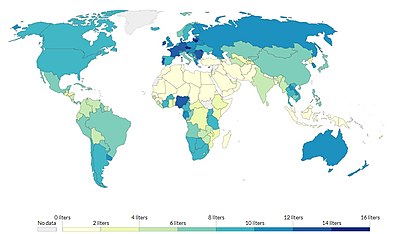

The average number of people who drink as of 2016[update]was 39% for males and 25% for females (2.4 billion people in total).[4]Females on average drink 0.7 drinks per day while males drink 1.7 drinks per day.[4]The rates of drinking varies significantly in different areas of the world.[4]
-
Age-standardised prevalence of current drinking for females (A) and males (B) in 2016, in 195 locations[4]
-
Average standard drinks (10 g of pure ethanol per serving) consumed per day, age-standardised, for females (A) and males (B) in 2016, in 195 locations[4]
Uses
[edit]Alcohol-related crimes
[edit]
Alcohol is used inrum-running,theillegal businessofsmugglingalcoholic beverages where such transportation is forbidden by law.
Wine fraudrelates to the commercial aspects of wine. The most prevalent type offraudis one wherewinesare adulterated, usually with the addition of cheaper products (e.g. juices) and sometimes with harmfulchemicalsand sweeteners (compensating for color or flavor).
Moonshineis illegal to produce and sell in most countries.
Astraw purchasermay receive money or recompense from the underage person in exchange for purchasing the alcohol on their behalf.
Alcohol has been used as a currency fortransactional sexin South Africa, and Uganda.[41][42][43]
Prunoalso known as prison hooch or prison wine, is a term used in theUnited Statesto describe an improvisedalcoholic beverage.It is variously made fromapples,oranges,fruit cocktail,fruit juices,hard candy,sugar,high fructose syrup,and possibly other ingredients, including crumbledbread.[44]
Activities
[edit]Drinking games
[edit]Drinking gamesaregameswhich involve the consumption of alcoholic beverages and often enduring the subsequentintoxicationresulting from them. Evidence of the existence of drinking games dates back to antiquity. Drinking games have been banned at some institutions, particularly colleges and universities.[45]
Beer
[edit]- Baseball
- Beer checkers
- Beer die
- Beer mile
- Beer pong(a paddle-less variant also known as "Beirut" )
- Beer pong (paddle game)
- Detonator
- Kastenlauf
- Quarters
- Wizard staff
Wine
[edit]Drinking songs
[edit]Adrinking songis a song sung while drinking an alcoholic beverage.
Beer
[edit]Whiskey
[edit]Experiences
[edit]Drinking establishments
[edit]Beer garden
[edit]Abeer garden(German:Biergarten) is an outdoor area in which beer and food are served, typically at shared tables shaded by trees.
Beer hall
[edit]Abeer hall(‹See Tfd›German:Bierpalast, Bierhalle) is a largepubthat specializes inbeer.
Cider house
[edit]Acider houseis an establishment that sells alcoholicciderfor consumption on the premises. Some cider houses also sell cider "to go", for consumption off the premises. A traditional cider house was often little more than a room in afarmhouseorcottage,selling locally fermented cider.
Ouzeri
[edit]Anouzeri(GreekουζερίIPA:[uzeˈri]) is a type of Greektavernwhich servesouzo(a Greek liquor) andmezedes(smallfinger foods).
Pulquerías
[edit]Pulquerías(or pulcherías) are a type oftaverninMexicothat specialize in serving an alcoholic beverage known aspulque.
Tiki bar
[edit]Atiki baris a themed drinking establishment that serves elaborate cocktails, especiallyrum-based mixed drinks such as theMai TaiandZombiecocktails.[46]Tikibars are aesthetically defined by theirtiki culturedécor which is based upon a romanticized conception of tropical cultures, most commonlyPolynesian.
Toddy shop
[edit]Atoddy shopis a drinking establishment seen in some parts of India (particularlyKerala) wherepalm toddy,a mildly alcoholic beverage made from the sap of palm trees, is served along with food.
Wine bar
[edit]Awine baris atavern-like business focusing on sellingwine,rather thanliquororbeer.A typical feature of many wine bars is a wide selection of wines available by the glass. Some wine bars are profiled on wines of a certain type of origin, such asItalian wineorChampagne.[citation needed]While many wine bars are private "stand-alone" establishments, in some cases, wine bars are associated with a specific wine retailer or other outlet of wine, to provide additional marketing for that retailer's wine portfolio. In countries where licensing regulations allow this, some wine bars also sell the wines they serve, and effectively function as a hybrid between awine shopand a wine bar.
Festivals
[edit]Beer festivals
[edit]Abeer festivalis an event at which a variety ofbeersare available for purchase. There may be a theme, for instance beers from a particular area, or a particular brewing style such as winter ales.
Wine festivals
[edit]Annualwine festivalscelebrateviticultureand usually occur after the harvest of the grapes which, in the northern hemisphere, generally falls at the end of September and runs until well into October or later. They are common in mostwine regionsaround the world and are to be considered in the tradition of other harvest festivals.
Tasting
[edit]Beer tasting
[edit]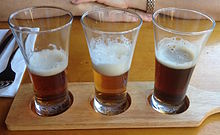
Beer tastingis a way to learn more about the history, ingredients, and production of beer, as well as different beer styles, hops, yeast, and beer presentation. A common approach is to analyze the appearance, smell, and taste of the beer, and then make a final judgment on the beer's quality. There are various scales used by beer journalists and experts to rate beer, such as the 1-20 scale used by British sommelier Jancis Robinson and the 1-100 scale used by American sommelier Joshua M. Bernstein. Professional organizations like the Wine & Spirit Education Trust often rate beer using verbal grades ranging from "faulty" to "outstanding" on a 1-5 scale.
Wine tasting
[edit]Wine tasting,on the other hand, is the sensory examination and evaluation of wine. While the practice of wine tasting is ancient, a more formalized methodology has been established since the 14th century. Modern, professional wine tasters use specialized terminology to describe the range of perceived flavors, aromas, and general characteristics of a wine. More informal, recreational tasting may involve similar terminology, but with a less analytical process and a more general, personal appreciation of the wine.
Tourism
[edit]Beer tourism
[edit]Craft beer tourismrefers to tourism where the primary motivation of travel is to visit a brewery,beer festival,beer related activity or other event that allows attendees to experience all aspects of the craft beer-making, consuming and purchasing process.[47]
Wine tourism
[edit]Enotourism,oenotourism, wine tourism, orvinitourismrefers totourismwhose purpose is or includes the tasting, consumption or purchase ofwine,often at or near the source. Where other types of tourism are often passive in nature, enotourism can consist of visits to wineries,tasting wines,vineyard walks, or even taking an active part in the harvest.
Food
[edit]Apéritifs and digestifs
[edit]Anapéritifis any alcoholic beverage usually served before a meal to stimulate theappetite,[48]while adigestifis any alcoholic beverage served after a meal for the stated purpose of improving digestion.Fortified wine,liqueurs,anddry champagneare common apéritifs. Because apéritifs are served before dining, they are usually dry rather than sweet. One example isCinzano,a brand ofvermouth.Digestifs include brandy, fortified wines and herb-infused spirits (Drambuie).
Cooking
[edit]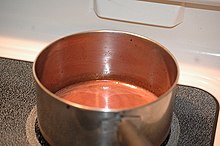
Pure ethanol tastesbitterto humans; some people also describe it as sweet.[49]However, ethanol is also a moderately effectivesolventfor many fatty substances and essential oils. This facilitates the use of flavoring and coloring compounds in alcoholic drinks as a taste mask, especially indistilled drinks.Some flavors may be naturally present in the beverage's raw material. Beer and wine may also be flavored before fermentation, and spirits may be flavored before, during, or after distillation. Sometimes flavor is obtained by allowing the beverage to stand for months or years in oak barrels, usually made of American or French oak. A few brands of spirits may also have fruit or herbs inserted into the bottle at the time of bottling.
Wine is important in cuisine not just for its value as an accompanying beverage, but as a flavor agent, primarily instocksandbraising,since its acidity lends balance to richsavoryorsweetdishes.[50]Wine sauceis an example of a culinary sauce that uses wine as a primary ingredient.[51]Natural wines may exhibit a broad range of alcohol content, from below 9% to above 16%ABV,with most wines being in the 12.5–14.5% range.[52]Fortified wines(usually with brandy) may contain 20% alcohol or more.
Food preservative
[edit]Alcohol has been used to preserve food.[53]
This sectionneeds expansion.You can help byadding to it.(March 2024) |
Drinking food
[edit]Terms for foods always served with alcoholic beverages:
- Anju—Korean term for drinking food
- Kap klaem—Thai term for drinking food
- Sakana—Japanese term for snacks served while drinking
Vinegar production
[edit]Vinegar(vyn egre;sour wine) is anaqueous solutionofacetic acidand trace compounds that may includeflavorings.Vinegar typically contains from 5% to 18% acetic acid by volume.[54]Usually, the acetic acid is produced by a doublefermentation,converting simplesugarstoethanolusing yeast and ethanol to acetic acid usingacetic acid bacteria.[55]
The source materials for making vinegar are varied – different fruits, grains, alcoholic beverages, and other fermentable materials are used:[56]
- Apple cider vinegar,or cider vinegar, is a vinegar made fromcider.[57]
- Rice vinegaris a vinegar made fromrice wine.
Wine and food matching
[edit]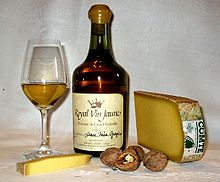
Wine and food matchingis the process of pairingfooddishes withwineto enhance the dining experience. In many cultures, wine has had a long history of being astapleat the dinner table and in some ways both thewinemakingandculinarytraditions of a region will have evolved together over the years. Rather than following a set of rules, local cuisines were paired simply with local wines. The modern "art"of food pairings is a relatively recent phenomenon, fostering an industry of books and media with guidelines for pairings of particular foods and wine. In therestaurantindustry,sommeliersare often present to make food pairing recommendations for the guest. The main concept behind pairings is that certain elements (such as texture and flavor) in both food and wine interact with each other, and thus finding the right combination of these elements will make the entire dining experience more enjoyable. However,tasteand enjoyment are verysubjectiveand what may be a "textbookperfect "pairing for one taster could be less enjoyable to another.[58]
Offerings
[edit]Folk saints
[edit]Alcoholic beverages are typical offerings for thefolk saintMaximón,[59]andSanta Muerte.[60][61]Both folk saints have been described asnarco-saints.[62][63]
Religious
[edit]Libation
[edit]Alibationis aritualpouring of a liquid, or grains such as rice, as anofferingto adeityor spirit, or inmemory of the dead.It was common in manyreligionsofantiquityand continues to be offered in cultures today.Wineor other alcoholic drinks are often used for libation.
Africa
[edit]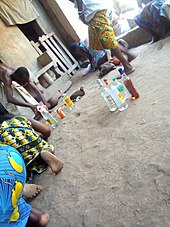
Libation was part ofancient Egyptiansociety where it was a drink offering to honor and please the various divinities, sacred ancestors, humans present and humans who are alive but not physically present, as well as the environment.[64]It is suggested that libation originated somewhere in the upper Nile Valley and spread out to other regions of Africa and the world.[65][66]According toAyi Kwei Armah,"[t]his legend explains the rise of a propitiatory custom found everywhere on the African continent: libation, the pouring of alcohol or other drinks as offerings to ancestors and divinities."[67]
Americas
[edit]In theQuechuaandAymaracultures of the South AmericanAndes,it is common to pour a small amount of one's beverage on the ground before drinking as an offering to thePachamama,or Mother Earth. This especially holds true when drinkingChicha,an alcoholic beverage unique to this part of the world. The libation ritual is commonly calledchallaand is performed quite often, usually before meals and during celebrations. The sixteenth century writerBernardino de Sahagúnrecords the Aztec ceremony associated with drinkingoctli:
Libation was done in this manner: whenoctliwas drunk, when they tasted the newoctli,when someone had just madeoctli...he summoned people. He set it out in a vessel before the hearth, along with small cups for drinking. Before having anyone drink, he took upoctliwith a cup and then poured it before the hearth; he poured theoctliin the four directions. And when he had poured theoctlithen everyone drank it.[68]
Sacramental wine in Christianity
[edit]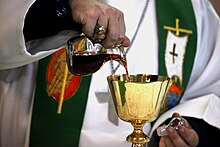
The amount ofsacramental wineconsumed during theEucharistis typically limited to a single sip or small portion, which does not result in a measurable increase in the participant'sblood alcohol content.This controlled and symbolic consumption of the sacramental wine is an integral part of the Eucharistic rite and does not lead to intoxication.
Catholic Church
[edit]According to theCatholic Church,the sacramental wine used in the Eucharist must contain alcohol. Canon 924 of the presentCode of Canon Law (1983)states:
§3 The wine must be natural, made from grapes of the vine, and not corrupt.[69]
Lutheranism
[edit]InLutheranism,theCatechismteaches:[70]
289. What are the visible elements in the Sacrament?
The visible elements are bread and wine.
935. Matt. 26:26-27 Jesus took bread… Then He took the cup.
Note: “The fruit of the vine” (Luke 22:18) in the Bible means wine, not grape juice. See also 1 Cor. 11:21[70]
SomeEvangelical Lutheran Church in America(ELCA) congregations make grape juice available for children and those who are abstaining from alcohol and some will accommodate those with an allergy to wheat, gluten, or grapes.[71]
Tincture
[edit]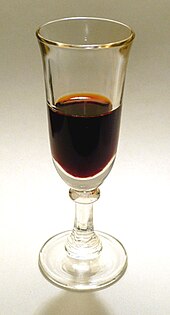
Atinctureis typically anextractof plant or animal materialdissolvedinethanol(ethyl alcohol).Solventconcentrations of 25–60% are common, but may run as high as 90%.[72]Inchemistry,a tincture is asolutionthat has ethanol as its solvent. Inherbal medicine,alcoholic tinctures are made with various ethanol concentrations, which should be at least 20% alcohol for preservation purposes.[72][73]
Other
[edit]Aflaming drinkis often ignited for aesthetic and entertainment purposes.
Alcoholic beverage may be consumed to celebrate observances such as theInternational Beer Day,International whisk(e)y day,orNational Vodka Day.They also drink them for social events likeInternational Women's Collaboration Brew Day,where people come together to make beer.
Alcohol measurement
[edit]Alcohol concentration
[edit]| Fruit juices | < 0.1% |
| Cider, wine coolers | 4%–8% |
| Beers | typically 5% (range is from 3–15%) |
| Wines | typically 13.5% (range is from 8%–17%) |
| Sakes | 15–16% |
| Fortified wines | 15–22% |
| Spirits | typically 30%-40% (range is from 15% to, in some rare cases, up to 98%) |
Theconcentrationof alcohol in a beverage is usually stated as the percentage ofalcohol by volume(ABV, the number of milliliters (ml) of pure ethanol in 100 ml of beverage) or asproof.In theUnited States,proofis twice the percentage of alcohol by volume at 60 degrees Fahrenheit (e.g. 80 proof = 40% ABV).Degrees proofwere formerly used in the United Kingdom, where 100 degrees proof was equivalent to 57.1% ABV. Historically, this was the most dilute spirit that would sustain thecombustionofgunpowder.
Ordinarydistillationcannot produce alcohol of more than 95.6% by weight, which is about 97.2% ABV (194.4 proof) because at that point alcohol is anazeotropewith water. A spirit which contains a very high level of alcohol anddoes not contain any added flavoringis commonly called aneutral spirit.Generally, any distilled alcoholic beverage of 170 US proof or higher is considered to be a neutral spirit.[75]
Mostyeastscannot reproduce when the concentration of alcohol is higher than about 18%, so that is the practical limit for the strength of fermented drinks such as wine, beer, andsake.However, some strains of yeast have been developed that can reproduce in solutions of up to 25% ABV.[76]
Serving measures
[edit]Shot sizes
[edit]Shot sizesvary significantly from country to country. In theUnited Kingdom,serving size inlicensed premisesis regulated under theWeights and Measures Act (1985).A single serving size of spirits (gin,whisky,rum,andvodka) are sold in 25 ml or 35 ml quantities or multiples thereof.[77]Beer is typically served inpints(568 ml), but is also served in half-pints or third-pints. In Israel, a single serving size of spirits is about twice as much, 50 or 60 mL.
The shape of a glass can have a significant effect on how much one pours. ACornell Universitystudy of students and bartenders' pouring showed both groups pour more into short, wide glasses than into tall, slender glasses.[78]Aiming to pour one shot of alcohol (1.5 ounces or 44.3 ml), students on average poured 45.5 ml & 59.6 ml (30% more) respectively into the tall and short glasses. The bartenders scored similarly, on average pouring 20.5% more into the short glasses. More experienced bartenders were more accurate, pouring 10.3% less alcohol than less experienced bartenders. Practice reduced the tendency of both groups to over pour for tall, slender glasses but not for short, wide glasses. These misperceptions are attributed to two perceptual biases:
- Estimating that tall, slender glasses have more volume than shorter, wider glasses; and
- Over-focusing on the height of the liquid and disregarding the width.
Standard drinks
[edit]
There is no single standard, but astandard drinkof 10g alcohol, which is used in the WHO AUDIT (Alcohol Use Disorders Identification Test)'s questionnaire form example,[79]have been adopted by more countries than any other amount.[80]10 grams is equivalent to 12.7 millilitres.
Astandard drinkis a notional drink that contains a specified amount of purealcohol.The standard drink is used in many countries to quantify alcohol intake. It is usually expressed as a measure of beer, wine, or spirits. One standard drink always contains the same amount of alcohol regardless of serving size or the type of alcoholic beverage. The standard drink varies significantly from country to country. For example, it is 7.62 ml (6 grams) of alcohol in Austria, but in Japan it is 25 ml (19.75 grams):
- In the United Kingdom, there is a system ofunits of alcoholwhich serves as a guideline for alcohol consumption. A singleunit of alcoholis defined as 10 ml. The number of units present in a typical drink is sometimes printed on bottles. The system is intended as an aid to people who are regulating the amount of alcohol they drink; it is not used to determine serving sizes.
- In the United States, the standard drink contains 0.6 US fluid ounces (18 ml) of alcohol. This is approximately the amount of alcohol in a 12-US-fluid-ounce (350 ml) glass of beer, a 5-US-fluid-ounce (150 ml) glass of wine, or a 1.5-US-fluid-ounce (44 ml) glass of a 40%ABV(80 US proof) spirit.
Beverage-specific equipment
[edit]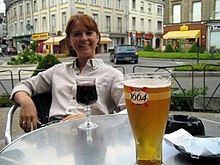
Professions
[edit]Laws
[edit]
Alcohol laws regulate the manufacture, packaging, labelling, distribution, sale, consumption, blood alcohol content of motor vehicle drivers, open containers, and transportation of alcoholic drinks. Such laws generally seek to reduce the adverse health and social impacts of alcohol consumption. In particular, alcohol laws set thelegal drinking age,which usually varies between 15 and 21 years old, sometimes depending upon the type of alcoholic drink (e.g., beer vs wine vs hard liquor or distillates). Some countries do not have a legal drinking or purchasing age, but most countries set the minimum age at 18 years.[1]
Some countries, such as the U.S., have the drinking age higher than the legal age of majority (18), at age 21 in all 50 states. Such laws may take the form of permitting distribution only to licensed stores,monopoly stores,orpubsand they are often combined with taxation, which serves to reduce the demand for alcohol (by raising its price) and it is a form of revenue for governments. These laws also often limit the hours or days (e.g., "blue laws") on which alcohol may be sold or served, as can also be seen in the"last call"ritual in US and Canadian bars, where bartenders and servers ask patrons to place their last orders for alcohol, due to serving hour cutoff laws. In some countries, alcohol cannot be sold to a person who is already intoxicated. Alcohol laws in many countries prohibitdrunk driving.
In some jurisdictions, alcoholic drinks are totally prohibited for reasons ofreligion(e.g., Islamic countries withsharia law) or for reasons oflocal option,public health,andmorals(e.g.,Prohibition in the United Statesfrom 1920 to 1933). In jurisdictions which enforce sharia law, the consumption of alcoholic drinks is anillegal offense,[81]although such laws may exempt non-Muslims.[82]
Alcohol and health
[edit]Alcohol is adepressant,which in low doses causeseuphoria,reducesanxiety,and increases sociability. In higher doses, it causesdrunkenness,stupor,unconsciousness,ordeath.A meta analysis of 107 cohort studies concludes low daily alcohol intake provides no health benefits and increased consumption, even at relatively low levels of daily intake (>2 beverages for women and >3 beverages for men), increases health- and mortality-risks.[83][84]
Short-term effects of alcohol consumption range from a decrease in anxiety and motor skills andeuphoriaat lower doses tointoxication(drunkenness), tostupor,unconsciousness,anterograde amnesia(memory "blackouts" ), andcentral nervous system depressionat higher doses.Cell membranesare highly permeable toalcohol,so once it is in the bloodstream, it can diffuse into nearly every cell in the body. Alcohol can greatly exacerbate sleep problems. Duringabstinence,residual disruptions in sleep regularity and sleep patterns are the greatest predictors ofrelapse.[85]Long-term use can lead to analcohol use disorder,an increased risk of developingphysical dependence,cardiovascular disease,andseveral types of cancer.

Some nations have introducedalcohol packaging warning messagesthat inform consumers aboutalcohol and cancer,as well asfetal alcohol syndrome.[86]The addition ofwarning labelson alcoholic beverages is historically supported byorganizationsof thetemperance movement,such as theWoman's Christian Temperance Union,as well as by medical organisations, such as theIrish Cancer Society.[87][88]
TheInternational Agency for Research on Cancerlists ethanol as acarcinogenand states that: "There is sufficient evidence and research showing the carcinogenicity of acetaldehyde (the major metabolite of ethanol) which is excreted by the liver enzyme when one drinks alcohol."[89]TheWorld Health Organizationalso considers alcohol to be a carcinogen with no quantity of consumption considered to be safe.[90]WHO estimates nearly half ofalcohol-attributable cancersin theWHO European Regionare linked to light or moderate drinking defined as "less than 1.5 litres of wine or less than 3.5 litres of beer or less than 450 millilitres of spirits per week".[90]
Public awareness of the link between alcohol consumption and cancer is alarmingly low in the U.S.[91]
See also
[edit]- List of alcoholic drinks
- List of national drinks
- List of whisky brands
- List of rum brands
- List of tequilas
- List of vodka brands
- Liquor
- Beer and breweries by region
- List of barley-based drinks
- List of beer cocktails
- List of cocktails
- List of IBA official cocktails
- Beer and breweries by region
- Alcoholic beverage industry in Europe
- Alcohol (chemistry)
- Homebrewing
- Non-alcoholic drink
References
[edit]- ^ab"Minimum Legal Age Limits".IARD.org.International Alliance for Responsible Drinking. Archived fromthe originalon 4 May 2016.Retrieved23 June2016.
- ^Henry, Yeomans (18 June 2014).Alcohol and Moral Regulation: Public Attitudes, Spirited Measures and Victorian Hangovers.Policy Press. p. 244.ISBN978-1-4473-0994-9.
- ^abJernigan, D; Ross, CS (March 2020)."The Alcohol Marketing Landscape: Alcohol Industry Size, Structure, Strategies, and Public Health Responses".Journal of Studies on Alcohol and Drugs. Supplement.Sup 19 (Suppl 19): 13–25.doi:10.15288/jsads.2020.s19.13.PMC7064002.PMID32079559.
- ^abcdefGriswold, Max G.; Fullman, Nancy; Hawley, Caitlin; Arian, Nicholas; Zimsen, Stephanie R M.; Tymeson, Hayley D.; Venkateswaran, Vidhya; Tapp, Austin Douglas; Forouzanfar, Mohammad H.; Salama, Joseph S.; Abate, Kalkidan Hassen; Abate, Degu; Abay, Solomon M.; Abbafati, Cristiana; Abdulkader, Rizwan Suliankatchi; Abebe, Zegeye; Aboyans, Victor; Abrar, Mohammed Mehdi; Acharya, Pawan; Adetokunboh, Olatunji O.; Adhikari, Tara Ballav; Adsuar, Jose C.; Afarideh, Mohsen; Agardh, Emilie Elisabet; Agarwal, Gina; Aghayan, Sargis Aghasi; Agrawal, Sutapa; Ahmed, Muktar Beshir; Akibu, Mohammed; et al. (August 2018)."Alcohol use and burden for 195 countries and territories, 1990–2016: a systematic analysis for the Global Burden of Disease Study 2016".The Lancet.392(10152): 1015–1035.doi:10.1016/S0140-6736(18)31310-2.ISSN0140-6736.PMC6148333.PMID30146330.
- ^"Alcohol Facts and Statistics".National Institute on Alcohol Abuse and Alcoholism.National Institute of Health.August 2018. Archived fromthe originalon 18 May 2015.Retrieved8 October2018.
- ^Zielinski, Sarah (16 September 2011)."The Alcoholics of the Animal World".Smithsonian.Archivedfrom the original on 22 August 2015.Retrieved29 July2015.
- ^Patrick, Clarence Hodges (1952).Alcohol, Culture, and Society.Durham, NC: Duke University Press (reprint edition by AMS Press, New York, 1970). pp. 26–27.ISBN978-0-404-04906-5.
- ^"'World's oldest brewery' found in cave in Israel, say researchers ".BBC News.15 September 2018.Retrieved26 January2021.
- ^Agencies (18 June 2024)."The oldest wine in the world has been preserved in a Roman mausoleum in Spain for 2,000 years".EL PAÍS English.Retrieved30 July2024.
- ^Cosano, Daniel; Manuel Román, Juan; Esquivel, Dolores; Lafont, Fernando; Ruiz Arrebola, José Rafael (1 September 2024)."New archaeochemical insights into Roman wine from Baetica".Journal of Archaeological Science: Reports.57:104636.Bibcode:2024JArSR..57j4636C.doi:10.1016/j.jasrep.2024.104636.ISSN2352-409X.
- ^Rosso AM (2012). "Beer and wine in antiquity: beneficial remedy or punishment imposed by the Gods?".Acta medico-historica Adriatica.10(2): 237–262.PMID23560753.
- ^Brostrom GG, Brostrom JJ (30 December 2008).The Business of Wine: An Encyclopedia: An Encyclopedia.ABC-CLIO. pp. 6–.ISBN978-0-313-35401-4.
- ^Chrzan, Janet (2013).Alcohol: Social Drinking in Cultural Context.Routledge. p. 13.ISBN978-0-415-89249-0.
- ^McGovern, P.E.; Zhang, J.; Tang, J.; Zhang, Z.; Hall, G.R.; Moreau, R.A.; Nunez, A.; Butrym, E.D.; Richards, M.P.; Wang, C.-S.; Cheng, G.; Zhao, Z.; Wang, C. (2004)."Fermented beverages of pre- and proto-historic China".Proceedings of the National Academy of Sciences.101(51): 17593–17598.Bibcode:2004PNAS..10117593M.doi:10.1073/pnas.0407921102.PMC539767.PMID15590771.
- ^Roach, John."Cheers! Eight ancient drinks uncorked by science".Nbc News.Archivedfrom the original on 4 April 2019.Retrieved9 June2013.
- ^McGovern P, Jalabadze M, Batiuk S, Callahan MP, Smith KE, Hall GR, Kvavadze E, Maghradze D, Rusishvili N, Bouby L, Failla O, Cola G, Mariani L, Boaretto E, Bacilieri R, This P, Wales N, Lordkipanidze D (November 2017)."Early Neolithic wine of Georgia in the South Caucasus".Proceedings of the National Academy of Sciences of the United States of America.114(48): E10309–E10318.Bibcode:2017PNAS..11410309M.doi:10.1073/pnas.1714728114.PMC5715782.PMID29133421.
- ^"The history and origins of cider".13 February 2019.Archivedfrom the original on 21 June 2021.
- ^"The History of Cider".25 April 2022.Archivedfrom the original on 29 October 2022.Retrieved29 October2022.
- ^Ancient Mashed Grapes Found in GreeceArchived3 January 2008 at theWayback MachineDiscovery News.
- ^al-Hassan, Ahmad Y.(2009). "Alcohol and the Distillation of Wine in Arabic Sources from the 8th Century".Studies in al-Kimya': Critical Issues in Latin and Arabic Alchemy and Chemistry.Hildesheim: Georg Olms Verlag. pp. 283–298.(same content also available onthe author's websiteArchived29 December 2015 at theWayback Machine); cf.Berthelot, Marcellin;Houdas, Octave V. (1893).La Chimie au Moyen Âge.Vol. I–III. Paris: Imprimerie nationale.vol. I, pp. 141, 143.
- ^abcForbes, Robert James (1970).A Short History of the Art of Distillation: From the Beginnings up to the Death of Cellier Blumenthal.Brill.ISBN978-90-04-00617-1.Archivedfrom the original on 23 January 2023.Retrieved28 June2010.
- ^Holmyard, Eric John(1957).Alchemy.Harmondsworth: Penguin Books.ISBN978-0-486-26298-7.pp. 51–52.
- ^Whiskey: Technology, Production and Marketing: Handbook of Alcoholic Beverages Series p2 Academic Press 2003
- ^Preventing Alcohol Abuse: Alcohol, Culture, and Control By David J. Hanson page 3
- ^"America's History of Drinking".Alcohol.org.
- ^Garrison, James Holley (1954). "Introduction to Part I". In Merrill, Walter McIntosh (ed.).Behold Me Once More. The Confessions of James Holley Garrison, brother ofWilliam Lloyd Garrison.Boston:Houghton, Mifflin.p. 4.
- ^"NOTABLE AUSTRALIAN EVENTS".The Sunday Times.No. 619. New South Wales, Australia. 7 November 1897. p. 9.Retrieved25 February2019– via National Library of Australia.
- ^Systembolaget.seAbout SystembolagetArchived18 October 2007 at theWayback Machine
- ^Edman, Johan (September 2015), "Temperance and Modernity: Alcohol Consumption as a Collective Problem, 1885–1913",Journal of Social History,49(1): 20–52,doi:10.1093/jsh/shv029
- ^Nelson, Max (2005).The Barbarian's Beverage: A History of Beer in Ancient Europe.Abingdon, Oxon: Routledge. p. 1.ISBN978-0-415-31121-2.Archivedfrom the original on 23 January 2023.Retrieved21 September2010.
- ^Martin Dworkin, Stanley Falkow (2006).The Prokaryotes: Proteobacteria: Alpha and beta subclasses.Springer. p. 169.ISBN978-0-387-25495-1.Retrieved29 July2011.
- ^Super, "Alcoholic Beverages", pp. 45–46.
- ^"Distilled spirit/distilled liquor".Britannica.Archivedfrom the original on 9 May 2008.Retrieved5 February2013.
- ^Lichine, Alexis.Alexis Lichine's New Encyclopedia of Wines & Spirits(5th edition) (New York: Alfred A. Knopf, 1987), 707–709.
- ^Lichine, Alexis (1987).Alexis Lichine's New Encyclopedia of Wines & Spirits(5th ed.). New York: Alfred A. Knopf. p. 236.ISBN978-0-394-56262-9.
- ^Robinson, J., ed. (2006).The Oxford Companion to Wine(3rd ed.). New York: Oxford University Press. p.279.ISBN978-0-19-860990-2.
- ^Ingraham, John L. (May 2010)."Understanding Congeners in Wine".Wine Business Analytics.Archived fromthe originalon 31 May 2023.Retrieved1 May2024.
- ^"Whisky hangover 'worse than vodka, study suggests'".BBC News.Archived fromthe originalon 23 January 2023.Retrieved19 December2009.
- ^"The 5 Basic Wine Characteristics".Wine Folly.23 July 2012.Archivedfrom the original on 15 March 2015.Retrieved6 May2015.
- ^"Alcohol consumption per person".Our World in Data.Archivedfrom the original on 16 March 2020.Retrieved15 February2020.
- ^Mihretie, GN; Kassa, BG; Ayele, AD; Liyeh, TM; Belay, HG; Miskr, AD; Minuye, B; Azanaw, MM; Worke, MD (2023)."Transactional sex among women in Sub-Saharan Africa: A systematic review and meta-analysis".PLOS ONE.18(6): e0286850.Bibcode:2023PLoSO..1886850M.doi:10.1371/journal.pone.0286850.PMC10249834.PMID37289839.
- ^Miller, A. P.; Pitpitan, E. V.; Nabukalu, D.; Nalugoda, F.; Nakigozi, G.; Kigozi, G.; Grabowski, M. K.; Kennedy, C. E.; Wagman, J. A. (2021)."Transactional Sex, Alcohol Use and Intimate Partner Violence Against Women in the Rakai Region of Uganda".AIDS and Behavior.25(4): 1144–1158.doi:10.1007/s10461-020-03069-9.PMC8807528.PMID33128109.
- ^Norris, AH; Kitali, AJ; Worby, E (October 2009). "Alcohol and transactional sex: how risky is the mix?".Social Science & Medicine.69(8): 1167–1176.doi:10.1016/j.socscimed.2009.07.015.PMID19713023.
- ^B. Lance, Courtney (February 2015).Pruno, Ramen, and a Side of Hope.Post Hill Press. p. 266.ISBN978-1618689252.
- ^Jillian Swords.The Appalachian:"New alcohol policy bans drinking games".September 18, 2007.ArchivedJuly 16, 2009, at theWayback Machine
- ^Kirsten, Sven (2000).The Book of Tiki.Taschen.p. 55.
- ^Franconi, Jennifer (2012)."Beer Tourists: Who Are They".Scholarworks @ Umass Amherst.
- ^Caton, S.J.; Ball, M; Ahern, A; Hetherington, M.M. (2004). "Dose-dependent effects of alcohol on appetite and food intake".Physiology & Behavior.81(1): 51–58.doi:10.1016/j.physbeh.2003.12.017.PMID15059684.S2CID22424908.
- ^Scinska, A; Koros, E; Habrat, B; Kukwa, A; Kostowski, W; Bienkowski, P (2000). "Bitter and sweet components of ethanol taste in humans".Drug and Alcohol Dependence.60(2): 199–206.doi:10.1016/s0376-8716(99)00149-0.PMID10940547.
- ^"6 Secrets of Cooking with Wine".Archivedfrom the original on 22 March 2017.Retrieved12 April2017.
- ^Parker, Robert M. (2008).Parker's Wine Buyer's Guide, 7th Edition.Simon and Schuster. p. 15.ISBN978-1-4391-3997-4.
- ^Jancis Robinson (2006).The Oxford Companion to Wine(3rd ed.). Oxford University Press.ISBN978-0-19-860990-2.Seealcoholic strengthat p. 10.
- ^"Ethanol as a food preservative".Retrieved21 April2024.
- ^"Acetic acid: general information".GOV.UK.Government Digital Service.Retrieved19 March2024.
- ^Nakayama, Takeyoshi (September 1959). "Studies on acetic acid-bacteria I. Biochemical studies on ethanol oxidation".The Journal of Biochemistry.46(9): 1217–1225.doi:10.1093/oxfordjournals.jbchem.a127022.
- ^"Vinegar".TH Chan School of Public Health, Harvard University. 1 October 2019.Archivedfrom the original on 14 November 2022.Retrieved4 March2020.
- ^Ulbricht CE, ed. (2010)."Apple Cider Vinegar".Natural Standard Herb & Supplement Guide: An Evidence-Based Reference(1st ed.). Elsevier. p. 59.ISBN978-0-323-07295-3.
- ^K. MacNeilThe Wine Biblepg 83-88 Workman Publishing 2001ISBN1-56305-434-5
- ^Khan, Gulnaz (24 January 2018)."Meet Maximón: The Liquor-Drinking, Chain-Smoking Saint".National Geographic.Archivedfrom the original on 12 June 2018.
- ^Araujo Peña, Sandra Alejandro; Barbosa Ramírez Marisela; Galván Falcón Susana; García Ortiz Aurea; Uribe Ordaz Carlos."El culto a la Santa Muerte: un estudio descriptivo"[The Santa Muerte Cult:A descriptive study].Revista Psichologia(in Spanish). Mexico City: Universidad de Londres.Retrieved7 October2009.
- ^Villarreal, Hector (5 April 2009)."La Guerra Santa de la Santa Muerte"[The Holy War of Santa Muerte].Milenio semana(in Spanish). Mexico City: Milenio. Archived fromthe originalon 16 October 2009.Retrieved7 October2009.
- ^Vincent, Isabel (21 December 2021)."Santa Muerte and five more 'religious' saints worshiped by drug cartels".New York Post.Retrieved10 June2022.
- ^Flannagin, Jake (September 2014)."The Rise of the Narco-Saints".The Atlantic.Retrieved10 June2022.
- ^Nehusi, Kimani S.K. (2016).Libation. An Afrikan Ritual of Heritage in the Circle of Life.University Press of America. p. 14.ISBN978-0-7618-6710-4.
- ^Delia, 1992, pp. 181-190[full citation needed]
- ^James, George G. M. (1954).Stolen Legacy.New York: Philosophical Library.
- ^Armah, Ayi Kwei (2006).The Eloquence of the Scribes: a memoir on the sources and resources of African literature.Popenguine, Senegal: Per Ankh. p. 207.
- ^Sahagún, Bernardino de; Nicholson, Henry B. (23 March 1997).Primeros Memoriales.University of Oklahoma Press.ISBN9780806129099– via Google Books.
- ^Code of Canon Law, 1983Archived19 June 2006 at theWayback Machine
- ^abWeber, Karl (31 May 2013)."Fruit of Which Vine?".Steadfast Lutherans.Retrieved18 April2024.
- ^An example of a church that does.See the "Sunday Worship" section on the "Welcome" page.
- ^abGroot Handboek Geneeskrachtige Planten by Geert Verhelst
- ^Ullian, Naomi (19 September 2016)."How To Make A Medicinal Mushroom Double-Extraction Tincture".Herbal Academy.Retrieved12 January2021.
- ^"Find the Alcohol Contents of Beer, Wine, and Liquor".Archivedfrom the original on 2 May 2015.Retrieved6 May2015.
- ^Lichine, Alexis.Alexis Lichine's New Encyclopedia of Wines & Spirits(5th edition) (New York: Alfred A. Knopf, 1987), 365.
- ^Stewart, Graham G. "Biographical Review: Seduced by Yeast".Journal of the American Society of Brewing Chemists(2015): 1–21.American Society of Brewing Chemists.21 January 2015. Web. 14 May 2017.
- ^"fifedirect – Licensing & Regulations – Calling Time on Short Measures!".Fifefire.gov.uk. 29 July 2008. Archived fromthe originalon 22 July 2011.Retrieved11 February2010.
- ^Wansink, Brian; van Ittersum, Koert (2005)."Shape of glass and amount of alcohol poured: comparative study of effect of practice and concentration".BMJ.331(7531): 1512–1514.doi:10.1136/bmj.331.7531.1512.PMC1322248.PMID16373735.
- ^"AUDIT The Alcohol Use Disorders Identification Test (Second Edition)"(pdf).WHO.2001.Archived(PDF)from the original on 20 January 2022.Retrieved2 January2020.
- ^Kalinowski, A.; Humphreys, K. (13 April 2016)."Governmental standard drink definitions and low-risk alcohol consumption guidelines in 37 countries".Addiction.111(7): 1293–1298.doi:10.1111/add.13341.PMID27073140.
- ^Williams, Lizzie.Nigeria: The Bradt Travel Guide.p. 101.
- ^Alcohol and Temperance in Modern Historyp. 329 David M. Fahey, Ian R. Tyrrell (2003)
- ^Bisognano, John (5 April 2023)."Daily Alcohol Intake and Risk of All-Cause Mortality".American College of Cardiology.
- ^"Moderate drinking not better for health than abstaining, analysis suggests".The Guardian.25 July 2024.ISSN0261-3077.Retrieved16 August2024.
- ^Feige B, Scaal S, Hornyak M, Gann H, Riemann D (January 2007). "Sleep electroencephalographic spectral power after withdrawal from alcohol in alcohol-dependent patients".Alcoholism: Clinical and Experimental Research.31(1): 19–27.doi:10.1111/j.1530-0277.2006.00260.x.PMID17207097.
- ^"Cancer warning labels to be included on alcohol in Ireland, minister confirms".Belfast Telegraph.26 September 2018.Archivedfrom the original on 11 April 2020.Retrieved20 February2023.
- ^Chandler, Ellen (2012). "FASD - Fetal Alcohol Spectrum Disorder".White Ribbon Signal.117(2): 2.
- ^Finn, Christina."Irish Cancer Society urges minister not to drop proposed cancer warning labels on alcohol products".TheJournal.ie.Archivedfrom the original on 20 February 2023.Retrieved20 February2023.
- ^Agents Classified by the IARC Monographs, Volumes 1–111Archived25 October 2011 at theWayback Machine.monographs.iarc.fr
- ^ab"No level of alcohol consumption is safe for our health".who.int.Archivedfrom the original on 12 January 2023.Retrieved12 January2023.
- ^Deep Links Between Alcohol and Cancer Are Described in New Report: Scientists continue to rethink the idea that moderate drinking offers health benefits.by Roni Caryn Rabin, the New York Times on Sept. 18, 2024. Last access 9/26/2024.

